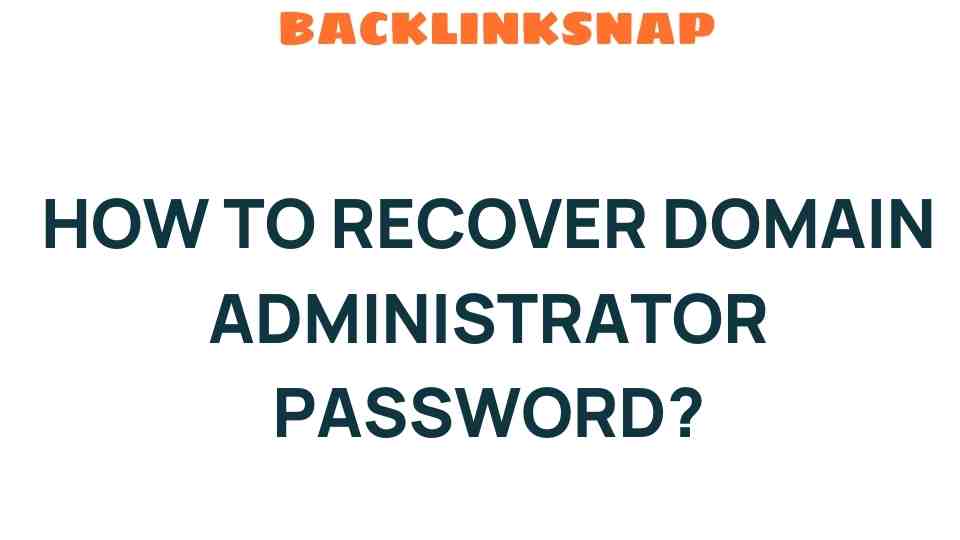Unlocking Access: How to Recover Your Domain Administrator Password
In the realm of IT security, the importance of maintaining access to critical accounts cannot be overstated. When it comes to Windows domains, the domain administrator password recovery process is vital for network administration and user authentication. Losing access to a domain administrator account can lead to significant operational disruptions, affecting everything from user management to security protocols. In this article, we’ll explore effective strategies for password reset, share insights from real-world experiences, and emphasize the importance of cybersecurity in the context of domain management.
Understanding Domain Administrator Accounts
A domain administrator account is a powerful tool in any organization’s IT infrastructure. This account typically has unrestricted access to all resources within a Windows domain, allowing the administrator to manage users, computers, and security policies. However, with great power comes great responsibility—and potential risks. If you forget or lose your domain administrator password, it can create a major headache, not just for you but for the entire organization.
The Importance of Password Recovery
Domain administrator password recovery is not just about regaining access; it’s about restoring control and ensuring that the organization’s IT infrastructure remains secure. In many cases, organizations have robust security measures in place, which can complicate the password recovery process. Here are some critical reasons why understanding password recovery is essential:
- Minimizing Downtime: Quick access recovery can reduce downtime, ensuring that IT operations continue smoothly.
- Safeguarding Data: Proper recovery methods help prevent unauthorized access to sensitive information.
- Compliance and Security: Many industries have compliance requirements regarding access to systems and data. A well-documented recovery process can help meet these standards.
Common Methods for Password Reset
When faced with a forgotten domain administrator password, there are several methods to consider for password reset. Each method has its pros and cons, and the right approach may depend on your organizational policies and the specific situation.
1. Using Active Directory Tools
If you have access to another account with sufficient privileges, you can reset the password directly through Active Directory Users and Computers (ADUC). Here’s how:
- Log in with an account that has admin privileges.
- Open the Active Directory Users and Computers management console.
- Locate the domain administrator account you wish to reset.
- Right-click the account and select Reset Password.
- Enter a new password and confirm it.
2. Booting into Safe Mode
If you cannot access any administrative accounts, rebooting the server into Safe Mode can provide another pathway to reset the password:
- Restart the server and press F8 before the Windows logo appears.
- Select Safe Mode with Command Prompt.
- Once in the Command Prompt, you can use the net user command to reset the password.
3. Third-Party Recovery Tools
For organizations without additional administrative accounts, third-party tools can be invaluable. Tools like Offline NT Password & Registry Editor or PCUnlocker may help reset passwords effectively:
- Download the tool and create a bootable USB drive.
- Boot the server from the USB and follow the prompts to reset the password.
Best Practices for IT Security
Recovering a domain administrator password is only half the battle. Ensuring that such situations are minimized in the future is crucial. Here are some best practices to consider:
- Regularly Update Passwords: Establish a schedule for regular password updates to reduce the risk of unauthorized access.
- Implement Multi-Factor Authentication (MFA): Adding an extra layer of security makes it much harder for attackers to access accounts.
- Document Recovery Procedures: Ensure that all IT staff are aware of the recovery procedures and that they are documented clearly.
- Conduct Regular Audits: Regularly audit accounts and permissions to ensure compliance and highlight potential vulnerabilities.
Conclusion
In the fast-paced world of network administration, the ability to recover a domain administrator password is a crucial skill. Not only does it restore access to a vital account, but it also underscores the importance of robust IT security practices. By understanding password reset methods and implementing best practices, organizations can enhance their cybersecurity posture and safeguard sensitive data. Remember, the goal is not just to recover access but to build a resilient IT environment that can withstand the challenges of modern cybersecurity threats.
FAQs
1. What is a domain administrator account?
A domain administrator account is a user account in a Windows domain that has full control over all domain resources, enabling management of users, computers, and policies.
2. What should I do if I forget my domain administrator password?
You can reset your password using Active Directory tools, boot into Safe Mode, or use third-party recovery tools. Each method has its specific steps and requirements.
3. Is it safe to use third-party password recovery tools?
While many third-party tools are reputable, it’s essential to research and ensure that the tool you choose has positive reviews and is known for reliability and security.
4. How can I prevent losing access to my domain administrator account in the future?
Implement best practices such as regular password updates, multi-factor authentication, and clear documentation of recovery procedures to minimize the risk of losing access.
5. What is multi-factor authentication (MFA)?
MFA is a security mechanism that requires two or more verification factors to gain access to an account, making it more secure than just a password alone.
6. How often should I audit my accounts for security compliance?
It’s recommended to conduct regular audits at least quarterly, though the frequency may depend on your organization’s size and regulatory requirements.
For more detailed guidelines on IT security, you can visit the NIST Cybersecurity Framework. For specific tools and resources related to password recovery, check out TechRepublic’s overview.
This article is in the category Digital Marketing and created by BacklinkSnap Team




